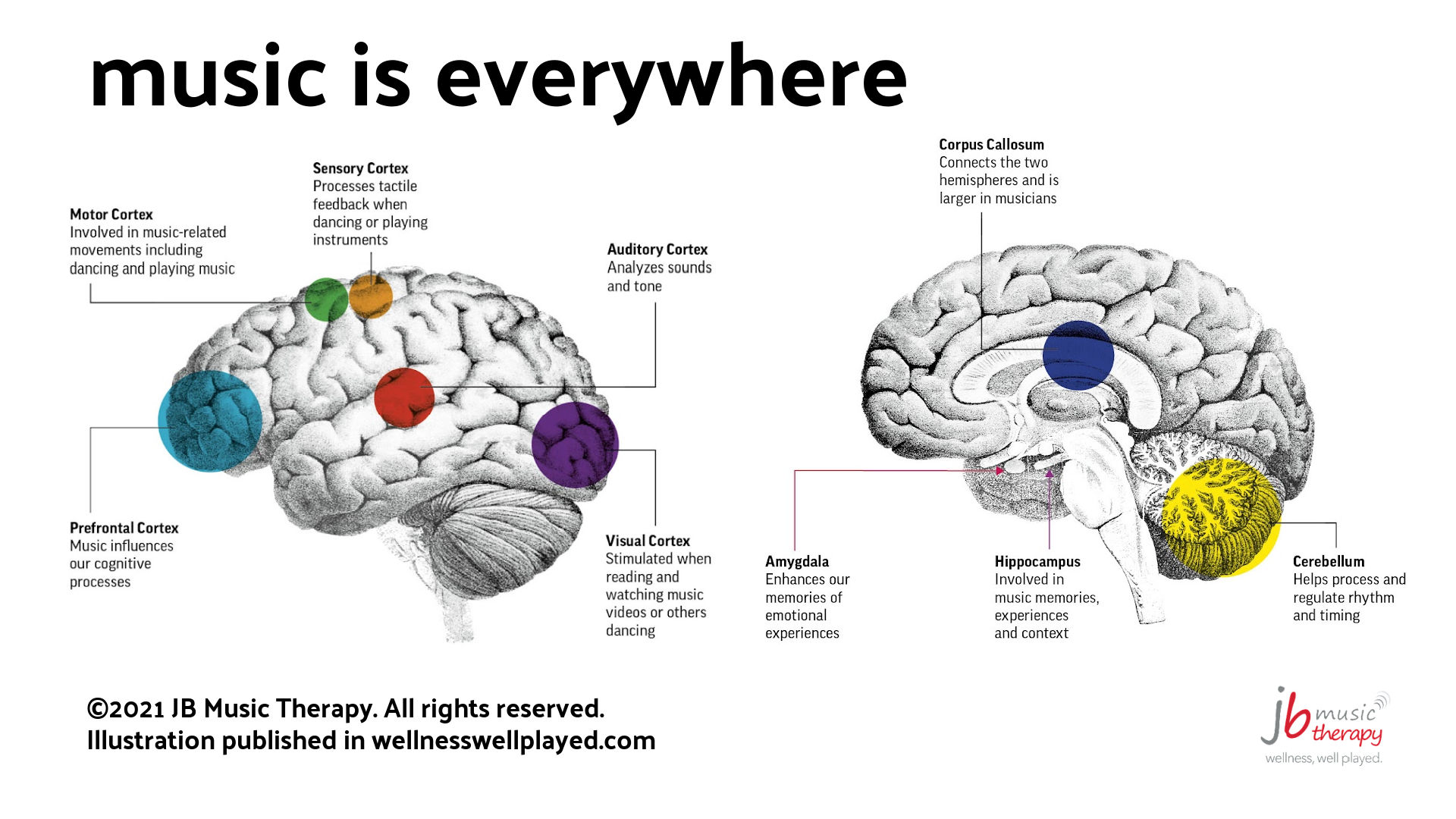Science is catching up with what music therapists have been witnessing for many decades — the fact that music can change the way a person feels, thinks, and behaves. Thanks to medical technologies, the public has awakened to the power and potential of using music in almost every health and educational context — and why it’s important that we do.
For thousands of years, people have sung, performed, and enjoyed music. Researchers have consistently observed that people from all corners of the world listen to or create some type of music, and that all people recognize music when they hear it. While music from various cultures differs in flavor and has myriad different meanings and emotions associated with it, every single culture makes music.
Neurologists have long known that there were areas of the brain specifically dedicated to processing music, and with the advent of advanced brain imaging technology, they’ve discovered that music’s reach is far more extensive than previously believed. When we listen to music, sound vibrations in the ear are converted to neural messages and transmitted to the thalamus, the brain’s “sensory relay station.” After reaching the thalamus, sound information is passed to the auditory cortex and instantaneously broken down into many different elements including, but not limited to, timing, pitch, and timbre (tone). Auditory information is also sent to other parts of the brain to be compared against historical associations and emotional responses (do I like it or not?), stimulating many parts of the brain in both hemispheres.
Although neurologists are still exploring how the auditory cortex functions, they now believe that music processing is much more complex than initially imagined, and involves many more parts of the brain than previously suspected.
Bonus – here is all the corresponding research from the book Wellness, Wellplayed (the home of this illustration)
| Prefrontal Cortex music influences our cognitive processes |
Moreno, S., Can Music Influence Language and Cognition? Contemporary Music Review, 2009. 28(3): p. 329-345. https://www.tandfonline.com/doi/pdf/10.1080/07494460903404410?needAccess=true |
|
Motor Cortex involved in music-related movements including dancing and playing |
Li, G., et al., Identifying enhanced cortico-basal ganglia loops associated with prolonged dance training. Scientific Reports, 2015. 5(1): p. 10271. Herholz, Sibylle C. and Robert J. Zatorre, Musical Training as a Framework for Brain Plasticity: Behavior, Function, and Structure. Neuron, 2012. 76(3): p. 486-502. https://www.nature.com/articles/srep10271#citeas https://hms.harvard.edu/news-events/publications-archive/brain/dancing-brain |
|
Corpus Callosum connects the two hemispheres and is larger in musicians |
Schlaug, G., et al., Increased corpus callosum size in musicians. Neuropsychologia, 1995. 33(8): p. 1047-1055. Münte, T.F., E. Altenmüller, and L. Jäncke, The musician’s brain as a model of neuroplasticity. Nat Rev Neurosci, 2002. 3(6): p. 473-8. Steele, C.J., et al., Early Musical Training and White-Matter Plasticity in the Corpus Callosum: Evidence for a Sensitive Period. The Journal of Neuroscience, 2013. 33(3): p. 1282-1290. https://pubmed.ncbi.nlm.nih.gov/8524453 https://pubmed.ncbi.nlm.nih.gov/12042882 https://www.jneurosci.org/content/33/3/1282 https://www.science.org/news/2008/04/music-builds-bridges-brain |
|
Amygdala enhances our memories of emotional experiences |
Hermans, E.J., et al., How the amygdala affects emotional memory by altering brain network properties. Neurobiol Learn Mem, 2014. 112: p. 2-16. Yang, Y. and J.-Z. Wang, From Structure to Behavior in Basolateral Amygdala-Hippocampus Circuits. Frontiers in Neural Circuits, 2017. 11(86). https://pubmed.ncbi.nlm.nih.gov/24583373 https://www.frontiersin.org/articles/10.3389/fncir.2017.00086/full https://hms.harvard.edu/news-events/publications-archive/brain/music-brain |
|
Cerebellum helps process and regulate rhythm and timing |
Nozaradan, S., et al., Specific contributions of basal ganglia and cerebellum to the neural tracking of rhythm. Cortex, 2017. 95: p. 156-168. https://pubmed.ncbi.nlm.nih.gov/28910668 https://hms.harvard.edu/news-events/publications-archive/brain/music-brain |
|
Sensory Cortex processes tactile feedback when dancing or playing instruments |
Olszewska, A.M., et al., How Musical Training Shapes the Adult Brain: Predispositions and Neuroplasticity. Frontiers in Neuroscience, 2021. 15(204). Borich, M.R., et al., Understanding the role of the primary somatosensory cortex: Opportunities for rehabilitation. Neuropsychologia, 2015. 79(Pt B): p. 246-255 https://www.frontiersin.org/articles/10.3389/fnins.2021.630829/full https://www.ncbi.nlm.nih.gov/pmc/articles/PMC4904790 https://hms.harvard.edu/news-events/publications-archive/brain/dancing-brain |
|
Auditory Cortex analyzes sounds and tone |
Nelken, I., Music and the Auditory Brain: Where is the Connection? Frontiers in human neuroscience, 2011. 5: p. 106-106. https://www.ncbi.nlm.nih.gov/pmc/articles/PMC3202228 https://hms.harvard.edu/news-events/publications-archive/brain/music-brain |
|
Hippocampus involved in music memories, experiences and context |
Koelsch, S., Investigating the neural encoding of emotion with music. Neuron, 2018. 98(6): p. 1075-1079 https://pubmed.ncbi.nlm.nih.gov/29953870 https://hms.harvard.edu/news-events/publications-archive/brain/music-brain |
|
Visual Cortex stimulated when reading music, watching others dance or music videos |
Huff, T., N. Mahabadi, and P. Tadi, Neuroanatomy, Visual Cortex, in StatPearls. 2021, StatPearls Publishing. Copyright © 2021, StatPearls Publishing LLC.: Treasure Island (FL) |

